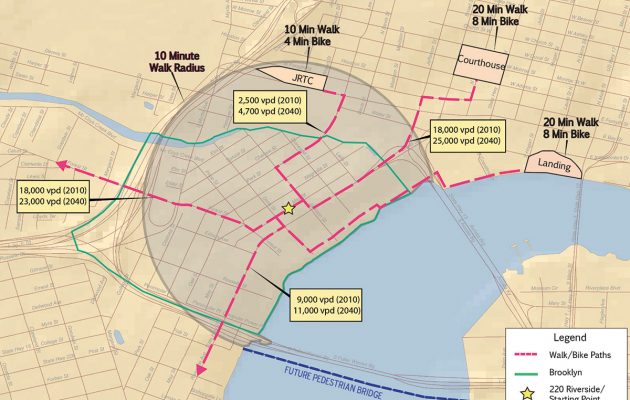New development spurs ‘road diet’ study

Fifteen years ago, before lots in Brooklyn were demolished to construct Forest Street, nearly all the lots were occupied by homes and businesses, and the median age of area residents was 51 to 65 years old.
Today, after the development of 220 Riverside, Brooklyn Station and the new YMCA, the median age is 38 and the largest age group, at 21 percent, is 25 to 29. According to a study initiated at the request of the Downtown Investment Authority earlier this year, the new apartment complexes and shift in demographics has given rise to a desire for a more walkable, bike-able commute to downtown Jacksonville.
The Riverside Avenue, Forest Street and Park Street Road Diet study currently being undertaken by Pond & Company, an engineering firm with a Jacksonville presence, began with stakeholder meetings in March and April to assess the challenges and the desires of residents and businesses in the Brooklyn area.
Stakeholders included City of Jacksonville Parks and Recreation and Planning and Development departments, FDOT, North Florida TPO, Downtown Vision, Inc., YMCA, The Community Foundation, Riverside Avondale Preservation, the Jacksonville Jaguars, Atlanta Federal Reserve Bank, Regency Centers, NAI Hallmark Partners, CBRE, local restaurants and residents.
At those meetings, feedback in general indicated the enhancements most desired were signage, crosswalks, sidewalks and security, followed by more retail, bike lanes, lighting, on-street parking, street trees and public spaces.
Following the stakeholders’ meetings, two public workshops were held following the Downtown Development Review Board’s regularly scheduled meetings May 17 and June 1.
The three corridors under review are Riverside Avenue from Unity Plaza to Water Street, Park Street from Unity Plaza down to Water Street at the convention center, and Forest Street from Riverside Avenue to the interstate.
The study looked at traffic volume and accidents, finding that crash history over the past five years indicates accidents are in proportion to the volume of traffic. Preliminary results of the traffic study indicate traffic volumes will remain below capacity with lane reductions and below capacity with potential reconfigurations at critical intersections (Riverside and Forest; Forest and Park).
Public comments at the June 1 DDRB meeting included several from Riverside and Avondale residents, including Fred Pope, who commented on the width of lanes on Riverside Avenue north of the Fuller Warren Bridge.
“You don’t need 12-foot-wide lanes in an urban setting, where speed limits are lower. The lanes in front of the Cummer Museum are only 10 feet wide,” he said.
However, one resident expressed a concern about future bottlenecks.
“By narrowing the roads, are we considering the growth in the area?” asked Kevin Kuzel, Avondale resident and executive assistant to District 14 Councilman Jim Love. Kuzel referred to new apartment developments forthcoming at St. Johns Village, Bishopgate, and 200 Riverside, which will have the potential for hundreds of vehicles heading downtown for work.
Both Allan Iosue, director of development at Pond & Company, and Fred Jones, DDRB Chair, had a rebuttal.
“The neighborhood is transforming,” said Iosue. “If you just focus on the car it will never change the mentality it is today.” Jones said, “It should be community over capacity. We consistently get bogged down over capacity issues.”
Riverside resident Kay Ehas requested the group expand the study to look at the traffic flow at Bay and Water Streets, which is difficult for pedestrians and cyclists to navigate, while Brad Thoburn, Jacksonville Transportation Authority vice president, said he would like the study to consider a “ground-level” utilization of the Skyway.
During evening rush hour, DDRB member Christian Harden said he found that “going from the highway down to six, then four, then two lanes southbound on Riverside within a half-mile stretch is difficult.”
A second public meeting will be held in July, but no date was available as of press time.
Concept revisions will then be presented to DDRB in August, followed by final recommendations in September.
By Kate A. Hallock
Resident Community News






